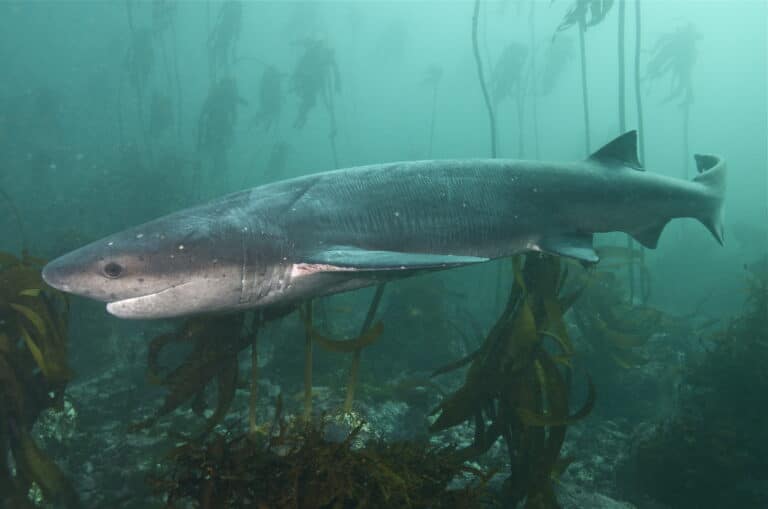South East Serengeti, Tanzania
Since the South African borders opened on 1 October we have tried to travel as much as possible in order to take advantage of experiencing wildlife areas that are currently quiet in terms of visitor numbers. Both Kenya and Tanzania have offered very good opportunities.
In 2018 we had the great pleasure of spending time at Namiri Plains which is an Asilia Africa camp located in the south eastern part of The Serengeti. We had exceptional wildlife sightings as well as had very good photographic opportunities, so we were very excited to be returning back this past November.
It is an exceptionally good area for seeing lion, cheetah and serval cats. In particular, we had a brief sighting of what I can honestly say is the best looking male lion I have ever seen. His name is Bob Junior and since that first sighting, I have been dreaming of seeing him again!
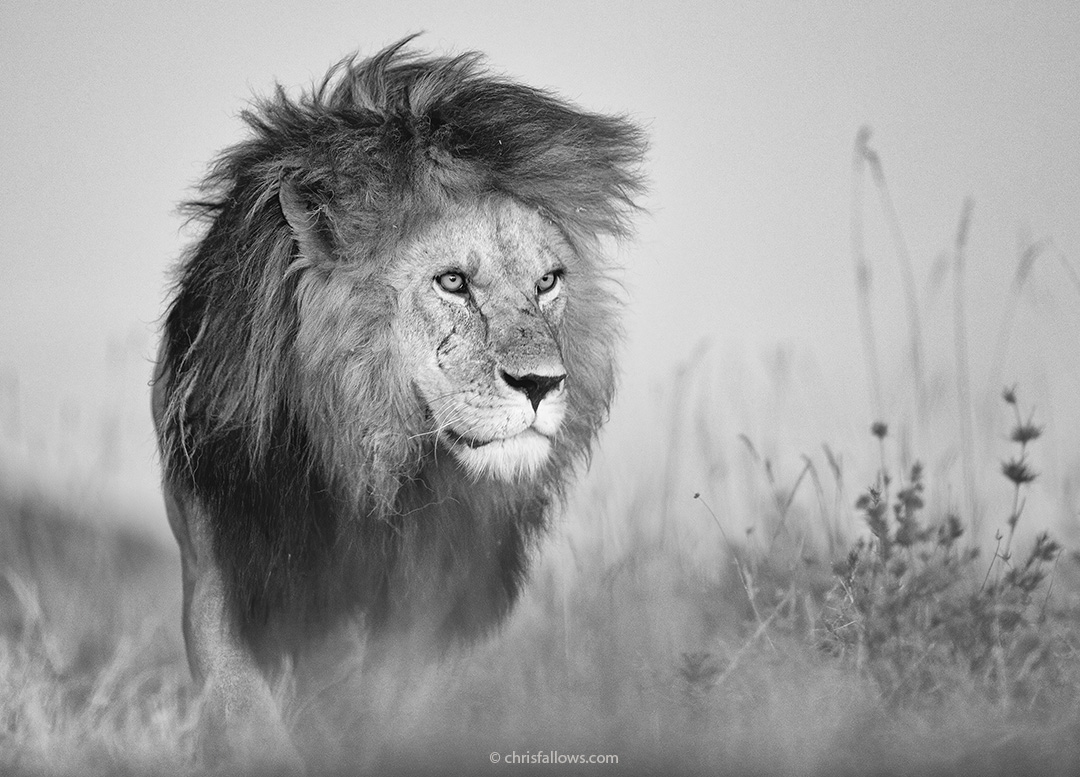
Our photographic goals were to be very specific. We were looking for the opportunity of seeing Bob Junior and with the area being home to a good number of Kopje clusters, any chance of photographing a predatory cat on the rocks was high on our agenda.
When visiting areas that one does not know especially well, it is vital to have a very good guide. In 2018 we were guided by Manja who had excellent spotting skills and a great passion for his subjects. Upon request, we were very fortunate to be able to have Manja guide us again on this trip.
Manja takes a very active interest in all the cats. He knows their family history and has very good knowledge of their various territories and behaviour. This is a great advantage in terms of being able to anticipate where a certain animal will move to and what it will do. He has incredible eye sight and we were constantly amazed at the excellent spots he made. He is also incredibly passionate and despite the amazing sightings we were to have, just sharing the time with him in the bush was a highlight.
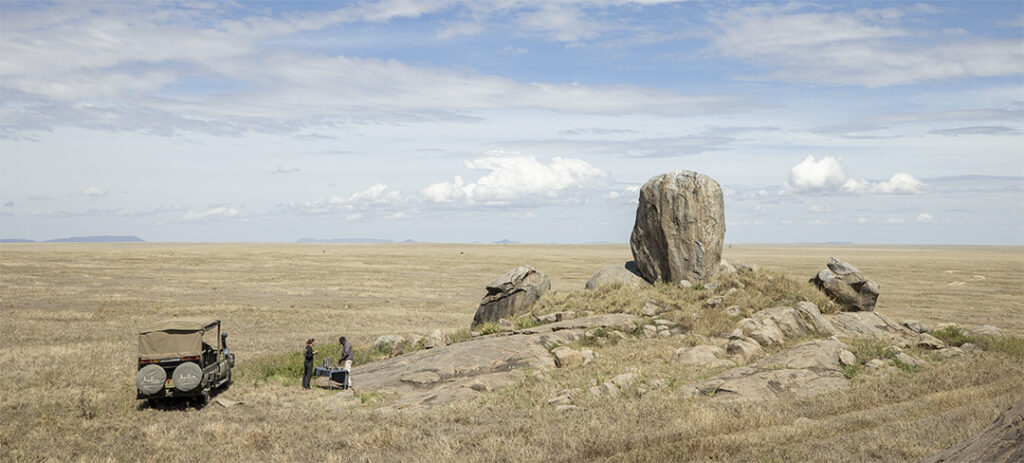
On our first afternoon we came across Bob Junior. He and his pride had camped out in an area called Semetu Kopjes. Semetu has 4 clusters of kopjes and a large water spring which helped to keep the lions in this area for most of our visit. It was a stroke of luck as we would not only have excellent sightings, we would also see very interesting behaviour.
Bob Junior has quite a history. He was fathered by an equally famous lion called Bob who due to his dreadlock encrusted black mane, was named after Bob Marley. Bob and his coalition brother, Ziggy, who also sported a black mane dreadlock style, reigned over many prides from 2008 to 2017.
Their good genes were passed onto Bob Junior who also has a luxuriant black mane stretching almost down to his stomach. He is meticulous with his grooming and not a dreadlock is to be found in his mane. In fact it looks as if he has just stepped out of a lion salon each morning. He is simply magnificent. Added to this he has a very special disposition. He is very relaxed and one could almost assume that he is gentle. Not much fazes him and you can get very close to him without disturbing him at all.
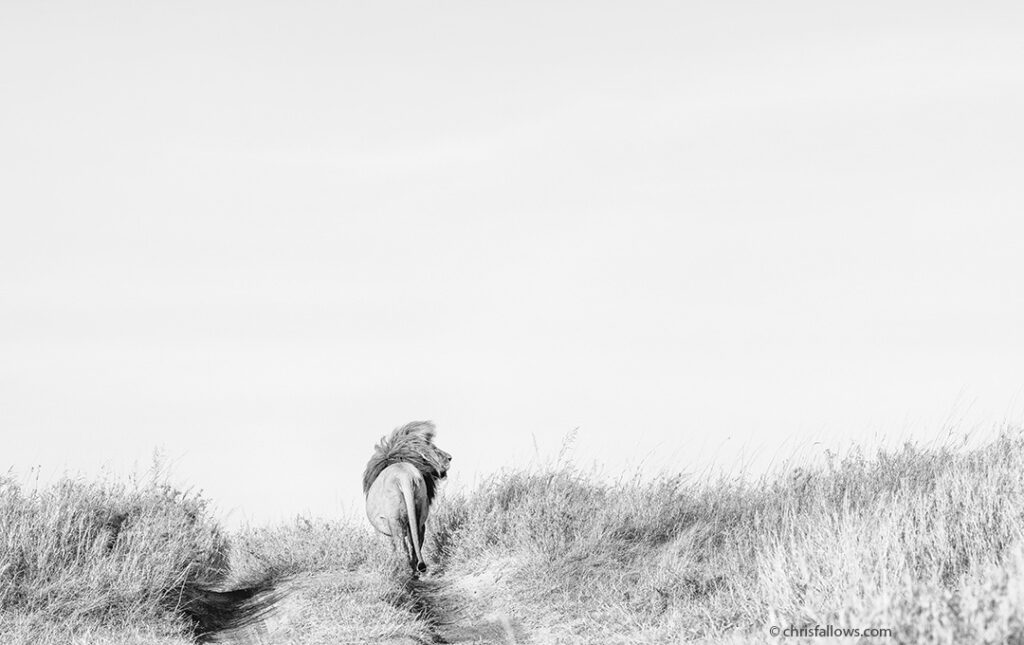
In 2018 Bob Jnr lost the pride that he alone presided over, to two other male lions. For two months he was missing in action but during that time he had been very fruitful. He formed a coalition with a younger, and also beautiful male. The guides here call him “Bob’s Friend” or “BF” but we preferred to call him “The Bullet”. The two returned two months later to win back their pride. This is not something we have heard of before in lion behaviour and we found this story quite incredible.
The current pride is made up of Bob Junior, The Bullet, four lioness and six cubs that are about 6 months old. Bob Junior also has another lioness, although not part of this pride that has 3 small cubs.
We had very good opportunities to photograph all these lions in the grass and walking down the roads, but would we be lucky enough to see any of them on the granite rocks? I will come back to this later!

The period of May to late November is actually very difficult for the predators of the Namiri Plains area. The wildebeest migration has left and the endless Serengeti Plains are practically devoid of game. A few gazelle’s (Grants and Thompsons) remain along with some small herds of Hartebeest. The former are more suitable for cheetah but difficult for the lions to catch. Excellent hunting skills are required and warthog now also appear on the lion menu.
It can be a very long and stressful waiting period for the first rains to come bringing along with it the return of the wildebeest.
However, if you scratch beneath the surface a little you will see that a whole other ecosystem exists in the grasslands. Thousands of rodents call this home and these attract a whole suite of predators ranging from many different species of owls, harriers, snakes and smaller cats. We had numerous sightings of African Wild Cat and five different sightings of serval. This is a cat that we hardly ever see and as such, each sighting is precious.
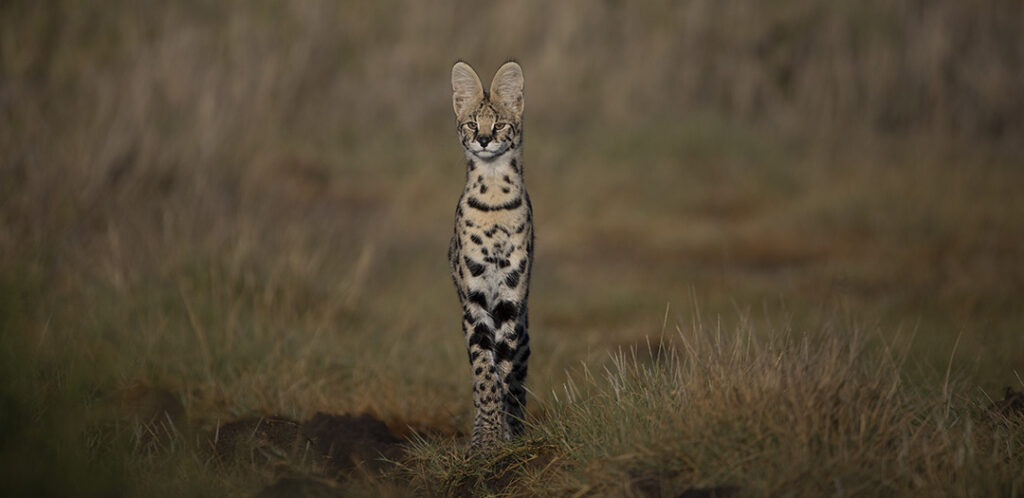
One in particular is a sighting I know we will never surpass. At dawn one morning we had found Bob Junior and his pride beside the Semetu Spring. As they entered their daytime snooze we had just headed off to look for Cheetah when Manja became very animated. He had just spotted a serval in the tall grass. Normally serval are very shy and most times will disappear into the long grass long before one gets a good look.
This particular female was exactly the opposite and actually approached us and our vehicle of her own accord, we think to get a better look of us. For a good number of minutes she sat very close to the car and gave us a long look over. The light and backgrounds were just spectacular and it gave Chris what will most likely be his best chance ever to photograph a serval. I don’t see that this serval opportunity will ever be beaten!

The habitat around Namiri is perfect for cheetah. The big open plains, which make sprinting after prey optimum, are home to gazelle and many termite mounds which the cheetah’s use to spot from.
Manja has observed some incredibly unique cheetah behaviour here especially regarding a mother cheetah that participated in two different cheetah cub adoptions. On two different occasions this female cheetah adopted and raised two cubs that were not her own. There is also an account of two male cheetah adopting a female cheetah cub. As it had already been weaned they were able to raise her by sharing food and teaching her to hunt. Once she matured they treated her as a sister and never mated with her.
This kind of behaviour has not been scientifically recorded before and now Manja is working closely with the cheetah researcher in The Serengeti to see if more of this behaviour can be recorded. There is so much we still do not know and it again shows how important it is to have passionate and dedicated naturalists in the field who have intimate knowledge of individual animals.
During our weeklong stay we saw thirteen different cheetah and observed two different hunts. The long grass provided beautiful backdrops for photographs and we even had the privilege of seeing a collation of three male cheetah on a kopje at dawn. We encountered them walking in the road close to camp just before dawn. Because Manja knows these cheetah so well, he immediately predicted they would proceed to a kopje close by called “chapatti rock” where they would mark territory.
He was 100% correct!
Chapatti rock was the perfect photographic platform. It was low enough to get underneath it to photograph and flat enough that the cheetah could be highlighted up again the sky using a wide angle lens.
The comical side of it was that their bellies were huge! They must have just consumed a massive meal of probably an adult Grants Gazelle and they now appeared to be pregnant!
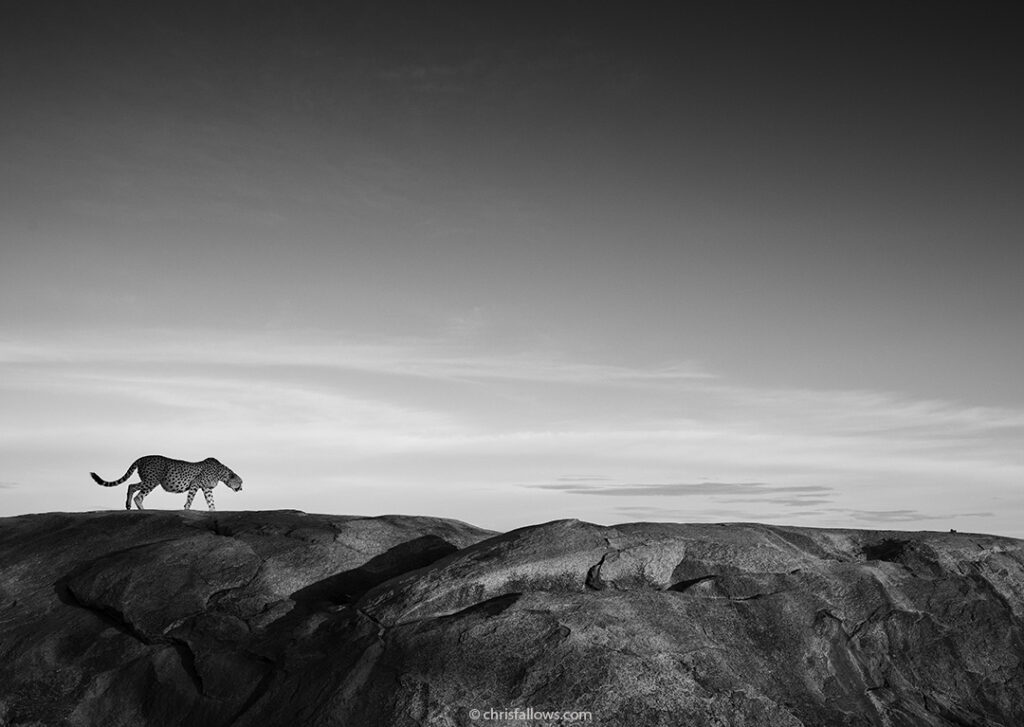
The following day we watched these same three male cheetah trying to hunt warthog. The chase took place over a 1 km stretch and involved two different warthog. It was interesting in that during the chase, the cheetah flew past a herd of Thompson gazelle who very clearly were not the preferred item on the menu. The appetite was definitely there for warthog only.
From a behaviour point of view it was fascinating to observe the three Cheetahs working in tandem. As one slowed the next, that had been following at a fast jog behind, would take over and switch to top gear. So as one cheetah tired, the next which simply just take over the chase. Although unsuccessful this time round, these 3 cheetah boys are clearly a very dangerous trio to encounter if you are potential prey.
We also came across a badly injured cheetah mum with four young cubs of about 4 months old. Already at this stage the cubs are more dependent on meat and daily hunts are a must. Once we got closer to the cheetah family we were dismayed to see that the mum had a severe limp of her right leg.
The following day, they were spotted by another game drive vehicle and she was reported to be in even worse shape. She hadn’t been able to hunt for a few days now and the bellies were extremely empty.
Finally on the third following day good news was reported over the radio. The cheetah mum was found feeding on an adult Grants gazelle. It seemed unbelievable that she managed to achieve this and it reiterates how brave predators have to be. If you are injured, you literally have no choice. You have to hunt no matter what. That is what survival is.
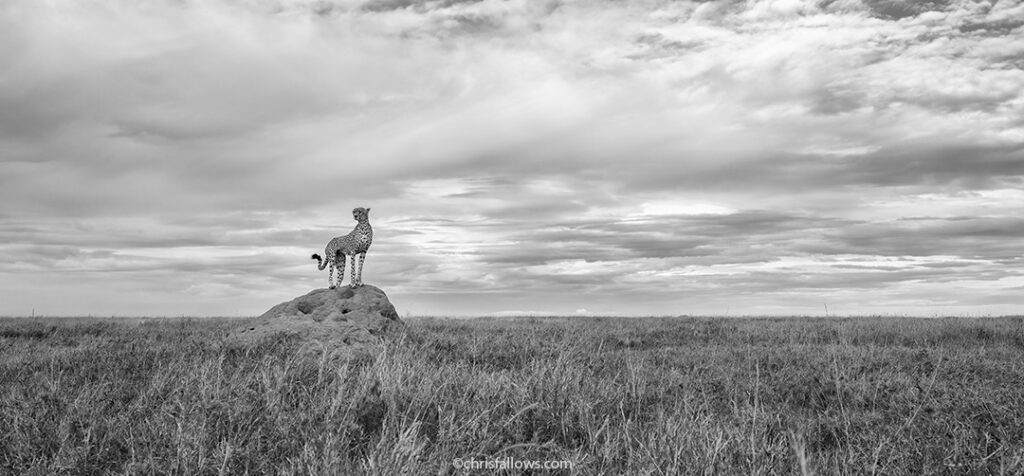
For the duration of our trip, Bob Junior lion pride sightings were a daily occurrence. Bob Junior might be the most beautiful male lion ever, but he has also managed to claim for himself the most intelligent lioness we have ever come across. And what a remarkable huntress she is …
It was mid-morning on one of the days that we saw a herd of about 8 hartebeest running in the direction towards where the lionesses were hidden in the long grass.
Hartebeest are vulnerable in this kind of habitat and we think this is why they were running. They were most likely feeling uncomfortable rather than having detected danger and it was just their bad luck that they happened to be running very close to a pair of hunting lioness.
What was to follow was the most incredible display of strategic hunting we have ever seen by lions. The dark nights are definitely to a lion’s advantage and this is when most of their successful hunts occur. During the day we always feel that they are pretty disorganised and have to be very lucky to successfully catch their prey.
Both of the lionesses saw the approaching herd and in order to not be seen, one of the lionesses did a very fast leopard crawl away from the approaching hartebeest and towards the road that was close by. By doing the leopard crawl she didn’t allow her shape to be visible above the tall grass and she reached the road undetected.
The hartebeest were running at a 45 degree angle away from where the other lioness was located in the grass and there was no doubt that this lioness knew she needed to get ahead of the herd in order to have a chance at being successful.
To do this, she reached the road and by maintaining a very low profile she performed a fast jog for over 100m until she got ahead of the herd. The road conveniently dipped down and hid her completely. Once in this position she crept back into the long grass just in front of the herd and lay in wait.
The hartebeest had no idea that she lay in wait. At probably 10 meters away the lead hartebeest suddenly spotted the lioness in the grass and so the lioness had to begin the chase. A mad dash by both ensued and the lioness was a brown blur as it sped across the grassland. Although it got within 5 meters, it was no match for the hartebeest.
Once it realised it would not be successful we could clearly see that she made a conscious decision to chase the herd back towards the other lioness, which she dually did.
The second lioness lay in wait and was ready, but at the last moment the herd spotted her as well.
The hunt ended unsuccessfully for the lionesses but we were left in absolute awe at what we had just seen. The lioness had clearly thought ahead of the game and had almost perfectly planned her move, and added to this, she made a critical adjustment when needed. She was not successful this time, but there is no doubt at what an incredible huntress she must be.
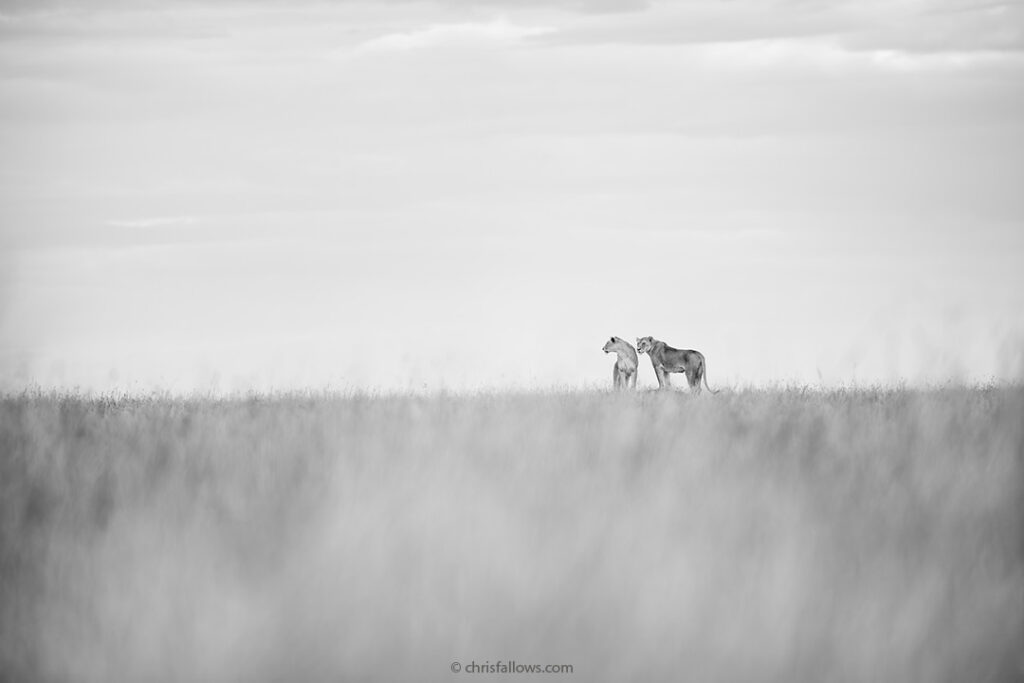
In fact on our last morning she was to show us yet again how cunning she was.
As the sun began to rise we spotted the first wildebeest herd to return back to the Namiri Plains since May. The clouds were heavy with rain and it had showered lightly during the night. The first proper rains would soon be falling, bringing with it the great wildebeest migration. After months of struggle, the lions were more than ready.
Upon seeing this herd Chris remarked that he certainly would not want to be the first wildebeest back and how true his words would turn out to be.
Our sightings began with the Bob Junior pride as well as an excellent cheetah sighting. As we begrudgingly prepared to head for the direction of Seronera airport, we saw the approach of the wildebeest herd that we had seen earlier in the morning. Another guide had informed us that he had seen the same two lioness moving at a fast jog to an area ahead of where the wildebeest were moving. To get to this point the two cunning felines had already needed to cover well over a kilometre from where we had last seen them. Fate was now leading the wildebeest directly to the lioness.
When she deemed them close enough she began her chase. From the outset we could see that she would not be successful but she continued her chase at a medium pace leading the wildebeest in a rightwards direction. I couldn’t help wondering why she was still chasing with no hope, when a second lioness appeared from nowhere in front of the herd. In no time at all she had tackled a wildebeest successfully to the ground and there was now no way out for the wildebeest.
Although we did not see the original setup of the hunt, we were left in no doubt that the first lioness knew exactly where she needed to lead the wildebeest, and that was right towards the other lioness who lay in wait.
No, you certainly do not want to be the first returning wildebeest …
Our objective and hope for this Serengeti trip was to have the chance to photograph cats on the granite kopjes.
In Kogatende we had an excellent opportunity of a female leopard on a spectacular granite boulder.
The 3 Namiri male cheetahs gave us an impressive show at sunrise on chapatti rock.
But would Bob Junior and The Bullet come to the party? Well, they did do so much sleeping that we were close to giving up on them!
It’s a very difficult photograph to achieve as most times the lions will choose the easiest rock to climb and one that offers the most shade from trees and bushes. It’s close to impossible to getting a clean shot at it. We did have one 5 second opportunity where a lioness had beaten Bob Junior to his favourite shady rock. In his attempt to find an alternative option he walked over to a beautiful clean ledge for a super quick surveillance. As I said it lasted no more than 5 seconds but we could have gone home happy with this.

However, on our very last afternoon game drive we were sitting with Bob Junior and The bullet as they finished off the remains of a warthog that one of the lionesses had caught. We had packed our cameras away and were about to leave when The Bullet got up. This is when the value of an excellent guide comes into play. Manja told us to standby because he thought the males would now begin marking territory. Close by was a magnificent rock with a perfect platform.
“They’ll mark on top of the rock”, said Manja. “Get ready”.
The light was fading fast but the sky was still highlighted by the setting sun and the big clouds hung suspended and filled with the promise of rain.
We only had minutes before needing to return back to camp, it was now or never.
Fortunately, in this case it was now and the moment we dreamed of appeared in front of our eyes. I could not believe it, two of the most gorgeous male lions now stood on top of the kopje and surveyed the territory they reigned over. The moment said everything … Kings of The Serengeti.
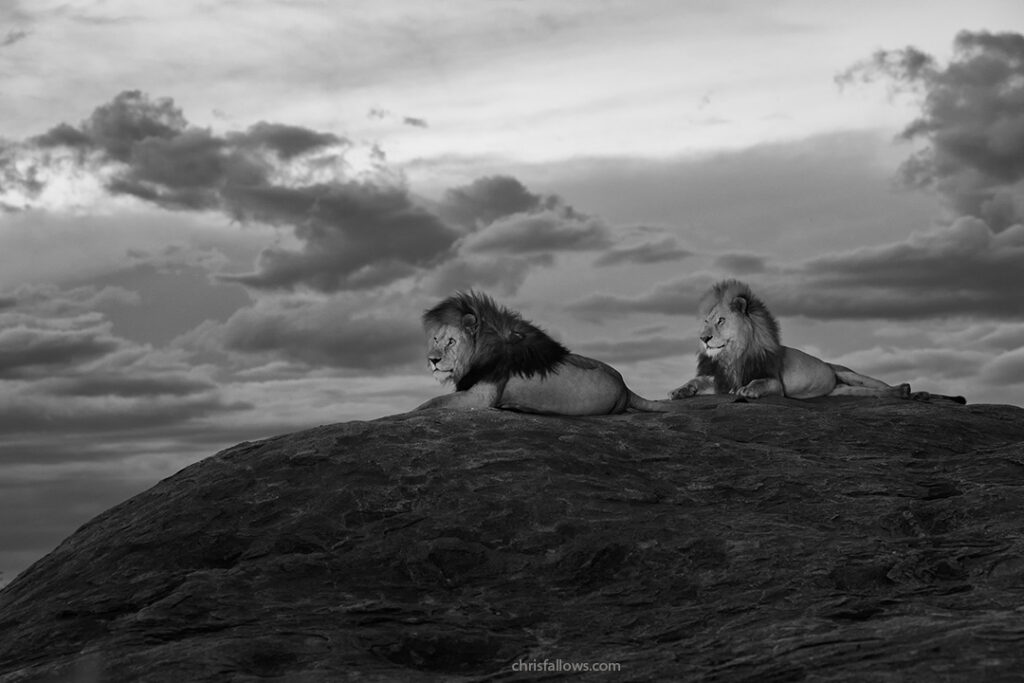
I was very emotional on our last morning. The people of East Africa have a very genuine warmth that in my opinion is not matched anywhere else in the world. The team at Namiri Plains had made us feel as if it was home and meeting the people here was as much of a highlight of the trip as was the wildlife. Most of the staff had gotten up earlier than normal on our last morning to say goodbye and send us off. With tears in our eyes we all hoped we would see each other again.
It was shortly after leaving camp that we had spotted that first herd of wildebeest mentioned above and the moment struck a very deep resonance in me.
The system here is so intricate and fragile, it needs every piece of the puzzle to be present in order for the balance to exist. The rains need to fall to provide the best grazing for the herbivores. And the predators need the rain to come in order to bring the prey back into their area. It’s a multi dependent system that we need to carefully preserve.
God Bless the Rains Down in Africa … Best of Southern Africa.



